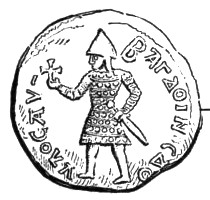Battle of Azaz (1125) facts for kids
Quick facts for kids Battle of Azaz |
|||||||
|---|---|---|---|---|---|---|---|
| Part of the Crusades | |||||||
 Baldwin II coin |
|||||||
|
|||||||
| Belligerents | |||||||
Principality of Antioch County of Edessa County of Tripoli |
Seljuk Turks Artuqids Burid dynasty |
||||||
| Commanders and leaders | |||||||
Joscelin I of Edessa Pons of Tripoli |
Aq-Sunqur il-Bursuqi Toghtekin |
||||||
| Strength | |||||||
|
3,100 1,100 knights 2,000 infantry |
15,000 | ||||||
| Casualties and losses | |||||||
| 20 including 5 knights | 1,000–5,015 killed | ||||||
The Battle of Azaz was a big fight between the Crusaders and a Muslim army. It happened on June 11, 1125. The Crusader forces were led by King Baldwin II. The Muslim army was led by Aq-Sunqur al-Bursuqi, a powerful leader from Mosul.
This battle was one of the most intense fights before the Second Crusade. The Crusaders won a clear victory. This win changed who had power in the Levant (the eastern Mediterranean area). It also made the Seljuk Turks less powerful in the region. One historian, Matthew of Edessa, wrote that the Crusaders chased al-Bursuqi's army all the way to Aleppo. The battle also ended the siege of the town of Azaz, saving it from being taken by the Turks.
Contents
Why the Battle Happened
In 1118, Joscelin I of Edessa had captured the town of Azaz in northern Syria. He took it from the ruler of Aleppo. The next year, the Crusaders faced a big defeat at the Battle of Ager Sanguinis. Their leader, Roger of Salerno, was killed. In 1123, King Baldwin II of Jerusalem was captured while he was in Edessa.
Before the Fight
King Baldwin II was set free in 1124. Soon after, he began to attack Aleppo on October 8, 1124. This caught the attention of al-Bursuqi, the Seljuk leader from Mosul. Al-Bursuqi marched south to help Aleppo. The city was close to giving up in January 1125 after being under attack for three months. Even though Aleppo was a very important city, Baldwin decided to pull back without fighting.
The Battle of Azaz
Later, al-Bursuqi attacked the town of Azaz. Azaz was north of Aleppo and belonged to the County of Edessa. Al-Bursuqi had also received more soldiers from Toghtekin of Damascus.
King Baldwin II, Leo I of Armenia, Joscelin I, and Pons of Tripoli gathered their forces. They had about 1,100 knights and 2,000 infantry soldiers. These soldiers came from their different lands, including Antioch. Baldwin was in charge of Antioch at the time.
They met al-Bursuqi outside Azaz. Al-Bursuqi's army was much larger. Baldwin pretended to retreat, which made the Seljuk army follow them away from Azaz. Once they were in the open, the Crusaders surrounded them. After a long and fierce fight, the Seljuks were defeated. Baldwin's army captured their camp. They took enough valuable items to ransom (pay to free) prisoners. These prisoners included the future Joscelin II of Edessa.
Who Was Hurt
Many soldiers were killed in the battle. According to Ibn al-Athir, more than 1,000 Muslim soldiers died. William of Tyre reported that 24 Crusaders died, while 2,000 Muslim soldiers were killed. Fulcher of Chartres said 5 Muslim leaders and 2,000 soldiers died. Matthew of Edessa estimated that 15 Muslim leaders and 5,000 soldiers were killed.
What Happened Next
After the defeat, al-Bursuqi went back to Aleppo. He left his son Masud in charge there. Then, he crossed the Euphrates River to Mosul. He planned to gather more soldiers to fight again.
This victory at Azaz was very important for the Crusaders. It helped them get back much of the power they had lost after their defeat in 1119. Baldwin wanted to attack Aleppo again. However, Antioch, which was now ruled by Bohemund II in 1126, stopped working with Edessa. So, the plan to attack Aleppo did not happen.
In 1128, Aleppo and Mosul joined together under a very strong ruler named Zengi. After this, the Crusaders' control over northern Syria began to weaken.

